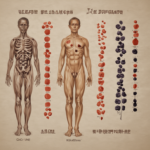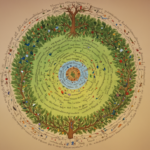Book Link 18 Human Genetics
<back next> — index
By the end of this section, you will be able to:
- Explain the basic principles of the theory of evolution by natural selection
- Describe the differences between genotype and phenotype
- Explore how gene-environment interactions shape physical and psychological traits.
Evolution, Genetics, and Psychology: Interconnected Influences
Learning Objective #1
Natural selection is a big part of how living things change over time, and it also affects how our minds work. For example, things like problem-solving and social skills can be shaped by natural selection because they help us survive and have babies. Studying how our minds have changed over time helps us understand why we think and act the way we do.
Two examples include cultural impacts on lactose tolerance and high-altitude living
Milk
 One example of how natural selection might have contributed to cultural differences across the world is the development of lactose tolerance in some populations.
One example of how natural selection might have contributed to cultural differences across the world is the development of lactose tolerance in some populations.
In regions where dairy farming became a major part of the economy, individuals who could digest lactose, the sugar in milk, had a survival advantage. Over time, this trait became more common in those populations.
As a result, cultural practices such as consuming dairy products and the prevalence of lactose tolerance vary across different regions based on the historical relationship between humans and dairy farming.
Mountains
 Another example is the adaptation to high-altitude environments. People living in high-altitude regions, such as the Andes or the Himalayas, have developed unique physiological and cultural adaptations to cope with low oxygen levels.
Another example is the adaptation to high-altitude environments. People living in high-altitude regions, such as the Andes or the Himalayas, have developed unique physiological and cultural adaptations to cope with low oxygen levels.
These adaptations, including differences in lung capacity and blood oxygen levels, have been shaped by natural selection to enhance survival in these challenging environments.
As a result, cultural practices and traditions in high-altitude populations may reflect adaptations to living at high elevations, such as specific agricultural practices or religious ceremonies related to the surrounding mountainous terrain
Learning Objective #2
 Genotype and phenotype are covered extensively in biology classes, as they are fundamental concepts in genetics and biology. However, these concepts also hold significant importance in psychology.
Genotype and phenotype are covered extensively in biology classes, as they are fundamental concepts in genetics and biology. However, these concepts also hold significant importance in psychology.
In psychology, understanding genotype (an individual’s genetic makeup) and phenotype (the observable characteristics resulting from the interaction of genetics and environment) is crucial for comprehending how genetic predispositions and environmental influences shape behavior, personality traits, and psychological development.
Nature vs Nurture
This understanding helps psychologists and researchers explore the complex interplay between nature and nurture in shaping an individual’s psychological makeup, including their cognitive abilities, emotional tendencies, and susceptibility to certain psychological conditions. Therefore, a thorough understanding of genotype and phenotype is essential for comprehending the intricate relationship between genetics and psychology.
Theorists
Of the psychology theoriests, Urie Bronfenbrenner, Erik Erikson, and James Marcia have made contributions to the relationship of one’s biology and psychological disposition.
 Bronfenbrenner’s Ecological Systems Theory emphasizes the interaction between genetics and environmental factors, shedding light on how these influences shape human development within various ecological systems.
Bronfenbrenner’s Ecological Systems Theory emphasizes the interaction between genetics and environmental factors, shedding light on how these influences shape human development within various ecological systems.
Erik Erikson’s psychosocial theory of development explores the impact of genetics and environment on the formation of an individual’s identity and psychological traits across different stages of life.
James Marcia’s theory of identity development delves into the interplay between genetics and environmental influences in shaping behavior and psychological traits, particularly during adolescence and emerging adulthood.
Learning Objective #3
The Big Five’s Neuroticism
Neuroticism, which is one of the Big Five personality traits, can be influenced by both genes and the environment. Genes can make a person more likely to feel negative emotions like anxiety and stress, which are part of neuroticism. These genetic tendencies can mix with things in a person’s life, like their childhood experiences, family, and stressful events, to affect how much neuroticism they show.
 Neuroticism is a personality trait that describes how likely a person is to feel negative emotions like anxiety, worry, and stress. If someone has high neuroticism, they might get upset easily and feel anxious a lot, while someone with low neuroticism tends to stay calm and not worry too much.
Neuroticism is a personality trait that describes how likely a person is to feel negative emotions like anxiety, worry, and stress. If someone has high neuroticism, they might get upset easily and feel anxious a lot, while someone with low neuroticism tends to stay calm and not worry too much.
For example, someone with genes that make them prone to higher neuroticism might show different levels of this trait based on how they were raised, their support from friends and family, and the tough things they’ve been through.
So, both genes and the environment work together to shape how much neuroticism someone has, showing that our genes and what happens around us both play a big part in our personality traits.
Parents
In families with strict, rule-focused parents, kids with a tendency to worry a lot might feel more anxious, while in families with more relaxed, permissive parents, the same kids might still feel anxious but in different ways. So, the mix of a child’s genes and the type of parenting they have can really shape how they feel and act.
Newer Psychology Perspectives
When it comes to resilience, gene-environment interactions play a role in how people bounce back from tough times. Some people might have genes that make them naturally more resilient, while others might need more support from their environment to develop resilience.
 Self-efficacy, which means believing in your own abilities, can also be influenced by genes and the environment. For example, a person’s genes might affect their confidence levels, while the support and encouragement they receive from their surroundings can also shape their self-belief.
Self-efficacy, which means believing in your own abilities, can also be influenced by genes and the environment. For example, a person’s genes might affect their confidence levels, while the support and encouragement they receive from their surroundings can also shape their self-belief.
Positive psychology, which focuses on happiness and well-being, can be influenced by gene-environment interactions too. Some people might have genes that make them more inclined to positive emotions, and their environment can further nurture these tendencies or work against them.
Summary
 In the first section, we explored the fundamental principles of evolution by natural selection and its impact on human behavior and traits. We learned how natural selection has influenced cognitive abilities, problem-solving skills, and social behaviors, shaping the way we think and act.
In the first section, we explored the fundamental principles of evolution by natural selection and its impact on human behavior and traits. We learned how natural selection has influenced cognitive abilities, problem-solving skills, and social behaviors, shaping the way we think and act.
The examples of lactose tolerance and high-altitude living demonstrated how cultural practices and physiological adaptations have been shaped by natural selection in different populations.
 Moving on to the second section, we delved into the concepts of genotype and phenotype, highlighting their significance in both biology and psychology. Understanding how genetic predispositions and environmental influences interact to shape behavior, personality traits, and psychological development is crucial in comprehending the intricate relationship between genetics and psychology.
Moving on to the second section, we delved into the concepts of genotype and phenotype, highlighting their significance in both biology and psychology. Understanding how genetic predispositions and environmental influences interact to shape behavior, personality traits, and psychological development is crucial in comprehending the intricate relationship between genetics and psychology.
The contributions of theorists such as Urie Bronfenbrenner, Erik Erikson, and James Marcia provided valuable insights into the interplay between genetics and environmental influences on human development and psychological disposition.